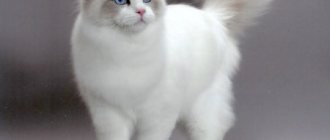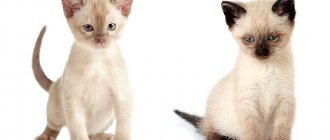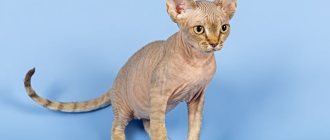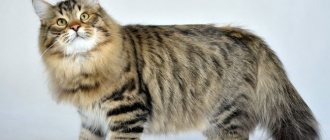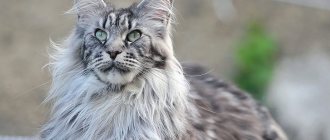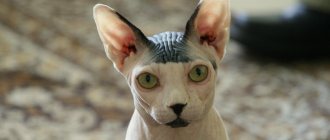This breed stands out from the rest with its silver-blue color and piercing green eyes. Russian blue cats are “real noblewomen”... graceful and mysterious creatures that delight their owners with their special charm and obedient disposition.
What are the differences between representatives of Russian blue cats, besides the amazing color?
- Body type . The body is medium (sometimes large) in size. The body is neat and slightly elongated. Russian Blue cats are characterized by flexibility and grace.
- Head . Wedge-shaped, with a powerful chin and large wide ears. Wide-set expressive eyes and a long straight neck.
- Tail . Sufficiently long in size with a pointed tip, the shade and density of the coat is no different from the rest of the silver color.
- Limbs . Long and thin, with round or oval feet. Possessing the plasticity of a panther, Russian Blue cats walk very softly and gracefully.
- Wool . The “coat” of this breed is short and dense, but unusually soft, like plush. Color – deep blue, almost blue, with a silver tint.
The eye color of Russian Blue cats is only green, but there are a lot of options, from a light pale green shade to a rich dark emerald color.
Where she came from?
The first documented facts about the origin of silver cats date back to 1893, when the breeder Mrs. Carew-Cox bought the first animals, which officially began the Russian Blue cat breed.
She wrote in her diaries that her favorites came to Great Britain from Arkhangelsk. The sailor who sold her the cats told her that such silver-blue cats could be found in villages in the north of the Russian Empire. To withstand the frost, the Russian Blue cat had to acquire a thick, fluffy double coat - a dense, smooth coat on top, and a soft, abundant undercoat underneath.
The silvery "blue" coloring was typical of many English cat breeds and they were bred together for a long time. The division occurred in 1912, from that moment the Russian blue cat had the opportunity to begin an independent path.
At the beginning of its formation, the appearance of the breed was different from what is familiar today. The first cats entered into the stud book were medium-sized, densely built animals, with a round head and oval-oblong ears.
The breed acquired its modern appearance later, in the middle of the last century. During World War II, the number of Russian Blues dropped so much that breeders decided to use Oriental cat breeds for breeding. This mixing gave the Russian Blue cat grace and a sophisticated silhouette, but spoiled the color - kittens began to be born of a color atypical for the breed.
Russian blues came to Russia from Czechoslovakia at the end of the last century.
Origin story
There is no exact data on the appearance of the breed. It was first widely described in a book by British cat lover Constance Carew-Cox, who brought the kitten to the UK from northern Russia in 1893.
This breed was a favorite at the royal court of the Russian Empire. The Russian blue cat was the favorite of Peter 1, and also the rat catcher at his court.
Catherine the Great loved cats less, but at the same time she gave them away to all foreign guests. It is thanks to this habit that the Russian Blue can be found all over the world.
The roots of the breed are laid in Russia. From its northern ancestors, the cat received a soft coat with a blue tint and a silver tint, but long paws and characteristic green, almond-shaped eyes indicate an admixture of Maltese and Siamese blood.
In the 20th century As a result of numerous wars, the breed practically disappeared, but in 1949 it was registered in the Association of Cat Fanciers. Real steps to bring the breed back were taken in the 50s and 60s - breeders resorted to crossing Russian cats with Siamese and other breeds, and by the beginning of the 70s the breed was completely restored to its original form. She returned to Russia in the 90s of the twentieth century.
Standards
The Russian Blue cat breed is recognized by all felinological organizations, each of which has adopted its own breed standard. In some respects they are similar, in others they have significant differences.
Today the breed includes the following types:
- English;
- European;
- American.
- Australian.
The first and last are similar to each other, but Europeans and Americans are significantly different.
Color and coat
The Russian Blue cat is prescribed to have a gray-blue color with a silver tint. This coloring is obtained due to the fact that each hair at the end has a lightened, almost white area and the fur seems to sparkle in the sun.
In the American type, the lightest color option is considered more preferable. In European style, moderate blue, mid-tone tones are considered the best.
Due to their pale coloring, Americans look more fit. On darker Europeans, the silvery tint characteristic of the Russian Blue cat is more noticeable.
Markings and uneven coloring are considered serious faults.
By all standards, the Russian Blue cat's coat is soft, silky and very thick. The undercoat and topcoat should be the same length and stand on end - not adjacent to the body.
Addition
The Russian Blue cat breed has an elegant and graceful build. Cats are significantly larger and more powerful than females. Standards require the Russian Blue cat to have well-developed muscles, a light build, and long bones. The overall silhouette should be flexible and delicate. Roughness and massiveness are considered disadvantages.
Head
The Russian Blue cat breed stands out among all other breeds with its facial expression and muzzle structure. The head should be wedge-shaped, the nose and forehead should be flat.
Different standards differ regarding the pinch - the special structure of the whisker pads that seem to stick out on the muzzle. According to the European standard, the Russian Blue cat is supposed to have a distinct pinch, while the American prefers smoother lines of the muzzle.
Eyes
In any type, the structure of the head allows the Russian Blue cat to attract maximum attention to its eyes. They should be a bright, rich green color, which is often compared to the sparkle of emeralds.
The Russian Blue cat is not allowed to have other colors and dull shades in any type.
Opinions differ regarding the shape of the eyes. Americans want a round shape, Europeans prefer an elongated, almond-shaped one.
Tail
The American type requires a long, moderately thick tail that is curved at the end. Europeans have a tail that is thick, even and of medium length.
Paws
When it comes to paws, standards differ the most. In the American type, the paws should be small and rounded, and the pads should be gray or gray-pink in color. The European Russian Blue cat is supposed to have oval paws, medium-sized and strictly pink in color.
Generally accepted characteristics of the breed
In order to avoid making a mistake when buying an expensive animal, you need to know the standard characteristics of the breed .
These include a uniform gray-blue color, short, with a thick lower layer of wool, silky to the touch and the same height throughout the animal’s body. The animals should have green eyes, a gray tip of the nose and gray-lilac-pink paw pads, a flat triangular-shaped muzzle, pointed at the tips, large, widely spaced ears, a strong, elongated muscular body, long, thick at the base and thinning towards the end tail, strong long legs.
Character and behavior
The Russian Blue cat is said to be a kind and affectionate animal. Representatives of the breed are distinguished by a calm character and balanced temperament. They will happily play with the owner or his children, but will not force communication.
Kind and affectionate with members of their family, these purrs are reserved towards strangers and try to avoid them.
Representatives of the breed usually have highly developed hunting instincts. It doesn't cost a Russian Blue cat anything to catch a mouse or even a rat. If rodents are not caught, they will eagerly hunt birds and insects.
At the same time, the Russian Blue cat breed easily puts up with the owners’ other animals: make friends with a dog, and a poultry or hamster will be completely safe.
Flaws
- If the owners do not take care in time to purchase a scratching post that is correctly selected for the height of the animal, then their wallpaper may be torn .
- Pets love to sleep next to their owners.
- Some representatives of the breed are very talkative , they like to purr next to their owners, but they do it quietly.
- They cannot stand moving , they are strongly attached to their home, and their new habitat can cause a negative reaction.
- They do not like guests, they are very afraid of strangers, they hide from them.
- They are always close to the owners, they need to know everything that is happening in the house.
- They may start hunting for pet parrots that have flown out of their cages.
Care
The Russian Blue cat breed is a very easy to care for pet. The short, elastic coat does not require additional brushing. Even for an exhibition, it is enough to wipe the cat with a cloth with a small amount of conditioner for shine and the animal will look luxurious.
In everyday life, a healthy cat takes care of its own toilet and makes sure its fur is clean and tidy.
The breed is not characterized by heavy seasonal shedding. Dead fur is replaced evenly throughout the year and there are no periods when everything around is covered with shedding wool.
Like any other cat, the Russian Blue cat needs the opportunity to sharpen its claws. To do this, you should put a special sharpener or a small stump in the corner.
Regular dental and ear checks will help prevent health problems.
Russian Blues are very neat animals and are easily trained to use the toilet in a tray, and even to use the toilet.
Breeding Features
Females of the Russian Blue breed mature at 6–8 months, but veterinarians advise delaying the first mating until one and a half years. Pregnancy usually proceeds without complications. Its duration is 63–68 days. There are from 3 to 6 kittens in one litter.
Kittens aged 5 weeks
The cat knows how to take care of her cubs. At first, she tries to hide them from prying eyes. Feeling a threat, she will protect the offspring - she will hiss and fight. Children need to be warned about the danger and asked not to touch the kittens. Mom feeds, licks the babies and raises them. As soon as their eyes open, the cat will teach them how to use the litter box.
Nutrition
A healthy cat has a good appetite and is unpretentious in food. Natural feeding is best for Russian Blue cats. These are not leftovers from the owners' table, but raw meat with bones, such as chicken wings or legs. Cats, despite many generations of living next to people, remain strict predators and are poorly adapted to digest plant foods.
The Russian Blue cat breed does not always fully absorb milk and dairy products, and should be given with caution.
Raw river fish may not be suitable for a Russian Blue cat, but it is useful to give sea fish at least once a week.
Under no circumstances should you give your Russian Blue cat boiled fish or boiled and fried bones!
If the owners do not have the opportunity to feed the cat natural food, the Russian Blue can also eat industrial ready-made food or “human food”. In this case, it is important to take care of clean water; when fed naturally, cats drink little, they only need moisture in the meat.
A healthy Russian Blue cat does not need vitamin supplements.
Place for a kitten in the house
Purchasing a Russian Blue kitten is hardly a spontaneous decision. Therefore, before the baby arrives in the house, his place must be arranged and everything necessary for maintenance and care must be prepared.
At least three stainless steel or earthenware bowls: short for wet food, medium for dry croquettes, deep for water.
A litter tray, or better yet two - one smaller one will be needed for the kitten in the first months of life, and the second one will be used by the kitten as an adult. As a rule, kittens, when leaving their first home, are already litter box trained and all that remains is to decide which brand of litter to use. It is quite possible to accustom a kitten to an empty tray with a grid - it is useful and hygienic: the filler granules will not fly away in all directions and be carried around the apartment by their paws. In this case, the task of neutralizing the odor is always solved by a cleanly washed tray.
Hygiene items - brushes and combs, a rubber brush for combing out dead hair, nail clippers, a suede cloth for polishing, a toothbrush for animals, the necessary set of pet products and towels for washing. The owner must take care of the cleanliness of all these accessories in the same way as his own. A Russian Blue cat should be accustomed to grooming from childhood, and then trimming its claws or another bath will not be a shock for either the animal or the person.
Toys are a mandatory and important component of the kitten’s socialization process. With equal pleasure, the little mermaid will chase both an ordinary bow on a braid and the beam of a laser pointer.
Therefore, what matters is not how expensive or technically advanced the toy is. The main thing is that it is not traumatic (breakable, cutting, heavy) and has a suitable size: a kitten that is too large will not be interested, a small one can be swallowed. Russian Blue kittens in their usual environment are usually very active, playful and do not lose these qualities with age.
Games help you hone your technique for moving gracefully through space.
A scratching post is also a familiar item for a nursery graduate. The owner has the choice of design and size - from a modest column covered with rope to a multi-level playroom complex - this absolutely necessary device.
A carrying bag is indispensable as a means of transport for visits to the veterinarian, trips and travel.
A bed is sometimes not considered a necessary item: about 90% of surveyed cat owners allow their pets to sleep in their bed. But still, the Russian Blue should have an individual place to sleep, to which the animal must be accustomed from childhood. “Put a piece of paper in the middle of a football field, and sooner or later a cat will lie on it”: purrs love to lie on something, be it the owner’s favorite designer blouse or a stack of freshly ironed linen. And Russian Blues are no exception.
To avoid such unpleasant surprises, you will need a crib or basket for the baby. Other useful items - harnesses for walking and swimming, a collar with an address medallion, warming and antistatic bedding - can be purchased later.
Cats use their sense of smell to a greater extent than their other senses to navigate unfamiliar environments. Having gotten used to the smell inherent in the owner and relating it to a calm environment, the baby will quickly get used to the new home and begin to enthusiastically explore the new space. There is no need to prevent this, but such educational excursions should not take place unsupervised.
The owner must use every opportunity for communication and joint games, not forgetting the words of encouragement for any, even the smallest, achievement of the baby. Very soon the kitten will begin to associate home and family with the most pleasant sensations - delicious food, love, a sense of comfort and security.
Who is a Russian Blue cat suitable for?
The Russian Blue cat breed is suitable for almost anyone who wants to have a calm and reliable friend.
The good nature, sociability and non-intrusiveness, responsiveness in play and communication characteristic of the Russian Blue cat make it an ideal pet for families with children. Docile and non-aggressive, Russian Blues will not resist a child's desire to cuddle a cat and are durable enough not to be accidentally damaged in play. They will be equally willing to run after a bow and purr on their knees, learn tricks and quietly wait for their owners to return home.
The Russian Blue cat breed is not characterized by wild games and excessive activity, characteristic of Oriental cats, but they cannot be called “real estate” like their English feline relatives.
Proper care during the adaptation period
The Russian Blue cat is naturally shy when changing its environment. Therefore, when you bring it into the house, you should not be afraid of its attempts to run away somewhere under the furniture. This is completely normal behavior. After a few weeks, complete adaptation to its territory will occur. During this entire period, you need to protect your pet as much as possible from communicating with strangers. It is advisable to allocate a separate room from all other pets.
Adaptation to a new place will almost always take a long time, even if the move is made with an adult. The support of loved ones at such moments is necessary, but often a cat can sit for many hours, huddled in a secluded place.
Leave her in this state for a couple of days and do not try to forcefully pick her up. She herself will make contact at the first opportunity, when she has at least a little mastered the surrounding territory.
It is better for a small kitten to get used to being surrounded by familiar things. Ask the former owners for some litter for the tray and food. Ask them about the habits that were instilled from the very first days of life. All this will allow you to at least slightly recreate the environment in which your pet grew up.
By highlighting a separate corner, you can mark the territory with some kind of barrier. To have somewhere to hide when scared, it is better to get a house for kittens or invent something similar with your own hands. This will eliminate situations of searching for your pet throughout the apartment.
What to look for when choosing?
Before buying a kitten, you should decide on the desired type.
Americans are slightly smaller, lighter in color, with a longer tail and narrow muzzle, and have a more active character.
Europeans are larger, darker, but their fur shimmers more, with an expressive face and a phlegmatic temperament.
Important points when purchasing:
- the kitten must be playful and healthy, the Russian Blue cat is not supposed to ignore bows and wiggling fingers;
- If you are planning a show career, pay close attention to the color of the eyes and coat of your purchase - they will not change with age!
- meet the parents of the future pet: you should not expect a good kitten from sick animals, with a bad character or a non-pedigreed appearance.
Table: pros and cons of the Russian Blue breed
| Characteristic | pros | Minuses |
| Appearance | bright appearance, rare color, beautiful sea-colored eyes | in fact, the cat's fur may not be bluish, but simply gray |
| Character | accommodating, indulgent, shy character | the pet is a little cowardly, can hide in closets, etc. |
| Health | good health, strong immunity, no predisposition to genetic diseases identified | — |
| Kitten price | you can find kittens with a pedigree costing from 8 thousand rubles | in prestigious nurseries the price for 1 kitten can exceed 35 thousand rubles |
| Difficulties in content | the cat is not capricious, quickly gets used to the proposed conditions, does not require much | the animal is afraid of closed doors |
| Difficulties in breeding | gives birth independently and quickly, 3–4 kittens can be born in a litter | sometimes it is difficult to find a purebred partner |
Where to buy?
A future show star can only be purchased from a nursery that professionally breeds this breed. It is difficult for Russian Blue cats to succeed at shows, so you need to choose very carefully.
See how the kitten's parents and his brothers and sisters from previous litters won exhibition victories. Do not forget that different international organizations describe the standard differently and a Russian blue cat of the European type is not in danger of success in the American association.
You can simply adopt a pet from neighbors or friends, but in any case it is worth meeting the mother and father of the kitten to make sure of their breed.
Under no circumstances should you buy a cat at the market! The Russian Blue cat breed cannot be there, only yard cats similar to them.
Vices of the Russian Blue breed
Russian Blue cats do not have a predisposition to any specific diseases. But any animal can still get sick. Therefore, there is no need to ignore veterinarians. Periodically (for example, once a year), you can take your pet to the veterinarian for a routine check-up. This will help avoid illness, and if it turns out that the cat is already sick, then thanks to a preventive visit, treatment will be started earlier. Moreover, the veterinarian remembers the necessary vaccinations better than the cat owner.
Periodic visits to the veterinarian will help avoid many diseases
Congenital abnormalities of blue cats can be defects associated with the structure of the skeleton:
- breaks, knots on the tail;
- sagging of the spine;
- curvature of the jaw;
- malocclusion;
- small stature.
With all these defects, a cat may well live to old age. They have special meaning only in cases where the cat was planned to be presented at an exhibition. Judges and experts will not allow the animal to participate. Problems in shows can also arise due to problems with the coat. The coat of this breed may turn brown. Otherwise, these cats have good health and strong immunity.
Defects in appearance
The main characteristic feature of the Russian Blue cat breed is its rare color. For this reason, a deviation from the standard is considered a serious defect. Sometimes two purebred representatives of the breed give birth to blue kittens with a white spot. This does not mean that one of the parents is a common impostor. Such a defect can appear in offspring in cases where both parents are carriers of the spotting polygene. This gene cannot be identified in advance, so you have to wait for the first litter. Kittens with such a marriage may have all the documents, including a pedigree, but breeders will immediately castrate/sterilize them.
Blue kittens with a color defect are sold at an even higher price than regular kittens of the same breed. But such animals can only become pets, since they will not be allowed into any exhibition with this defect.
cats with color defects cannot be bred
A cat will not be allowed to participate in the exhibition if it has at least one of the defects related to appearance:
- cryptorchidism (failure of the testicles to descend into the scrotum);
- strabismus, blindness, cataract, entropion (turned-in eyelids);
- oligodactyly (lack of fingers), syndactyly (fusion) or polydactyly (excess);
- jaw deformation (undershot, overshot, etc.).
Owner reviews
You can leave your reviews about the Russian Blue cat breed in the comments below, they will help other users with their choice!
Alyona
My husband and I decided on a Russian Blue cat when we were choosing a gift for our daughter for her 10th birthday and we didn’t regret it one bit! Our Dymka is the most peaceful and kind creature in the world, she sleeps with her daughter, plays with her, tolerates being dressed in dresses and has never even tried to escape! She has no fur at all, she doesn’t burp like her mother’s Persian, she doesn’t need to be combed, she’s always a beauty! They are also hypoallergenic, as their coat structure is special. My father-in-law came to us with allergies, but after a week he didn’t react to Haze at all, he got used to it. True, she didn’t want to go into his arms, in general she doesn’t really like strangers, she doesn’t go into his arms.
Catherine
I had Siamese cats for a long time and had no intention of changing the breed until I fell in love with a Russian Blue cat at an exhibition. A rare and beautiful breed, the judges like it and have an amazing character. After the orientals, who never sit still, they try to get into something, then they attack and scratch, in general it’s a real pleasure. And most importantly, he hardly meows. It purrs occasionally when walking and there is silence. He doesn’t fight with other cats and sleeps with his dog. Ideal breed!
